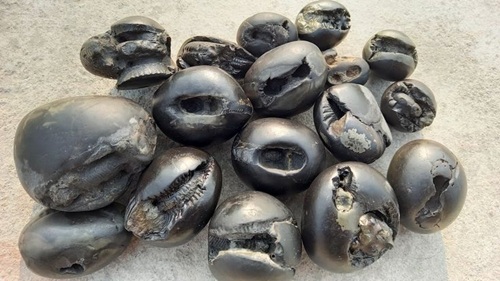Shaligram stones hold a sacred place in Hinduism, particularly in the worship of Lord Vishnu. These fossilized stones, primarily found in the Gandaki River of Nepal, are considered divine and spiritually potent. They are believed to bring prosperity, protection, and spiritual energy into homes and temples. Due to their high religious significance, the market is flooded with fake or imitation Shaligrams, making it essential to know how to identify original Shaligram stones before purchase.

Understanding Shaligram Stone
- Shaligram stones are fossilized ammonite shells, naturally formed over millions of years.
- They are primarily found in Nepal’s Gandaki River and occasionally in the foothills of the Himalayas.
- These stones are black or dark grey, with natural markings (chakras, patterns, or symbols) that are considered representations of Lord Vishnu’s symbols.
- Original Shaligrams are naturally formed, while fake ones are often man-made using resin or artificial carving.
Physical Characteristics of Original Shaligram Stone
a) Color and Surface
- Original Shaligrams are typically dark grey to black, sometimes with white or grey veins due to natural fossilization.
- The surface is smooth but not artificially polished; natural Shaligrams have slight roughness or irregularities.
- Fake Shaligrams may appear too glossy, shiny, or uniform, which is unnatural.
b) Markings and Symbols
- Authentic Shaligrams have natural markings, such as circular patterns, lines, or spiral formations.
- These markings are random, not identical, reflecting fossilized ammonite patterns.
- Counterfeit stones often have etched, carved, or painted symbols, which look too perfect or repetitive.
c) Weight and Density
- Original Shaligram stones are dense and heavy for their size due to natural fossilization.
- Fake stones made from resin or artificial material feel lighter and less solid.
d) Shape
- Natural Shaligrams are usually round, oval, or irregular, depending on how they were formed in the riverbed.
- Perfectly symmetrical or overly uniform shapes are likely man-made replicas.
Spiritual and Ritual Tests
- Water Test: When placed in water, real Shaligrams sink immediately due to their density, while some fake stones may float.
- Ritual Confirmation: Devotees sometimes observe spiritual energy or positive vibes when keeping Shaligrams near sacred spaces. While subjective, this is a traditional indicator used in temples.
Quick Practical Tips for Identification
| Feature | Original Shaligram Stone | Fake Shaligram Stone |
| Color & Surface | Dark grey/black, natural roughness | Too shiny or uniform |
| Markings | Random natural patterns | Etched, carved, or painted symbols |
| Weight & Density | Heavy and dense | Light, hollow, or artificial |
| Shape | Oval, round, or irregular | Perfectly uniform or symmetrical |
| Origin | Gandaki River, Nepal | Unknown or artificial sources |
Precautions When Buying
- Source from trusted dealers or temples in Nepal or India.
- Request proof of origin, especially if the stone claims to be from the Gandaki River.
- Be cautious of online purchases without certification.
- Avoid stones with excessive polish, uniformity, or artificial markings, as these are usually fake.
Final Thoughts
Identifying original Shaligram stones requires careful observation of color, weight, surface, markings, and origin. Genuine Shaligrams are naturally formed fossils, dense, irregular in shape, and carry unique spiritual markings. Fake or artificial stones, on the other hand, are often light, polished, or etched to mimic natural features. By following these guidelines, devotees and collectors can ensure authenticity, preserve spiritual value, and avoid financial loss.